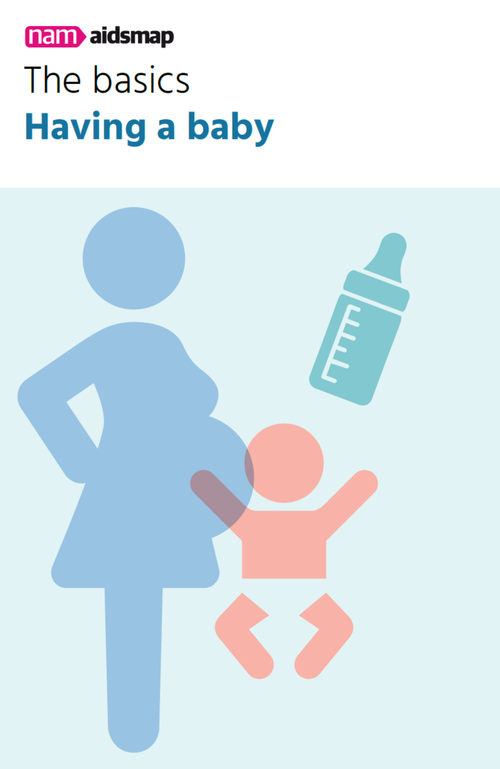
Key points
- HIV transmission is possible during pregnancy, labour, delivery and breastfeeding.
- Effective HIV treatment and other preventative measures have reduced vertical transmission of HIV to very low levels.
- With optimum care, the transmission rate may be between 0% and 0.5%.
Without any sort of treatment or care, the chance of a woman with HIV passing it on to her baby is considerable. Before antiretroviral therapy and other preventative measures were introduced, transmission rates per pregnancy were between 14 and 20% in European countries, and up to 43% in African countries. Transmission happened during pregnancy, around the time of labour and delivery, and through breastfeeding.
But with effective HIV treatment and a managed delivery, the risk of vertical transmission is greatly reduced. Transmission from pregnant women with diagnosed HIV has fallen to 0.3% and 0.2% in the UK and France respectively.
In 21 countries in sub-Saharan Africa surveyed in 2019, the transmission rate varied between 2 and 25%. The countries with the best figures were Botswana, Eswatini, South Africa and Namibia (all below 5%). Even in countries with good access to HIV treatment for pregnant women, gaps in services mean that the transmission rate is higher: for example, 8% in Zimbabwe and 11% in Kenya. The poorest results were in Nigeria and the Democratic Republic of Congo, where fewer than half of pregnant women receive HIV treatment. Across the continent, about half of this transmission occurs during pregnancy or delivery and the other half during breastfeeding.
With optimum care, the risk is low. For women who have an undetectable viral load (below 50) at the time of delivery, transmission rates are 0.1% and 0.3% in the UK and France respectively. The French study did not record a single transmission among over 5400 mothers who were taking HIV treatment at the time of conception, continued to take it throughout pregnancy, had an undetectable viral load at the time of delivery and did not breastfeed. In addition, there was a 0% transmission rate for over 2300 infants whose mothers were undetectable during the first trimester of pregnancy and who did not breastfeed.
HIV transmission during breastfeeding also depends on HIV treatment and viral load. If neither mother nor baby are on HIV treatment, there is around a 20% chance of the child acquiring HIV after two years of breastfeeding. A recent study in which women were taking treatment estimated the risk of transmission at 0.3% if a woman breastfeeds for six months and 0.6% if she breastfeeds for one year. An undetectable load further reduces the risk, but not to zero.
HIV treatment reduces the mother’s viral load so that the baby is exposed to less virus while in the womb, during birth and in breast milk. In addition, some anti-HIV drugs cross the placenta and enter the baby’s body where they can prevent the virus from taking hold.
A number of factors can increase the risk of HIV transmission, including having a high HIV viral load, a low CD4 count, HIV-related illness, a sexually transmitted infection or bacterial vaginosis. Women who acquire HIV during pregnancy or breastfeeding are at greater risk of passing on the virus as the viral load is very high soon after infection.
Mothers who have an undetectable viral load are usually recommended to have a vaginal delivery. For women with a high viral load (for example, over 1000), a caesarean delivery lowers the risk of HIV transmission. During childbirth, heavy bleeding and the baby having more contact with mother’s blood increases the risk of transmission, as does inflammation of the placenta (chorioamnionitis).
Giving the newborn baby a short course of anti-HIV drugs, called infant post-exposure prophylaxis (infant PEP), protects the baby. Feeding with formula milk lowers the risk of HIV transmission, but is only recommended in places with access to safe clean water. (If formula feed cannot be prepared with safe water, the risk of HIV is outweighed by the risk of other diseases). If breastfeeding, exclusive breastfeeding (breast milk only) is safer than mixed feeding (giving other food as well).
Flynn PM et al. Prevention of HIV-1 transmission through breastfeeding: efficacy and safety of maternal antiretroviral therapy versus infant nevirapine prophylaxis for duration of breastfeeding in HIV-1-infected women with high CD4 count (IMPAACT PROMISE): a randomised, open-label, clinical trial. Journal of Acquired Immune Deficiency Syndromes, 77: 383-392, 2018. doi:10.1097/QAI.0000000000001612 You can read more about this study in our news report.
Sibiude J et al. Perinatal HIV-1 transmission in France: U=U for mothers on ART from conception. Conference on Retroviruses and Opportunistic Infections, abstract 684, 2022. You can read more about this study in our news report.
Peters H et al. UK Mother-to-Child HIV Transmission Rates Continue to Decline: 2012–2014. Clinical Infectious Diseases 64: 527-528, 2017.
White AB et al. Antiretroviral interventions for preventing breast milk transmission of HIV. Cochrane Database of Systematic Reviews: CD011323. 2014. doi: 10.1002/14651858.CD011323
Working Group on Mother-To-Child Transmission of HIV. Rates of Mother-To-Child Transmission of HIV-1 in Africa, America, and Europe: Results From 13 Perinatal Studies. Journal of Acquired Immune Deficiency Syndromes and Human Retrovirology 8: 506-510, 1995.
UNAIDS. Progress towards the Start Free, Stay Free, AIDS Free targets. 2020.

